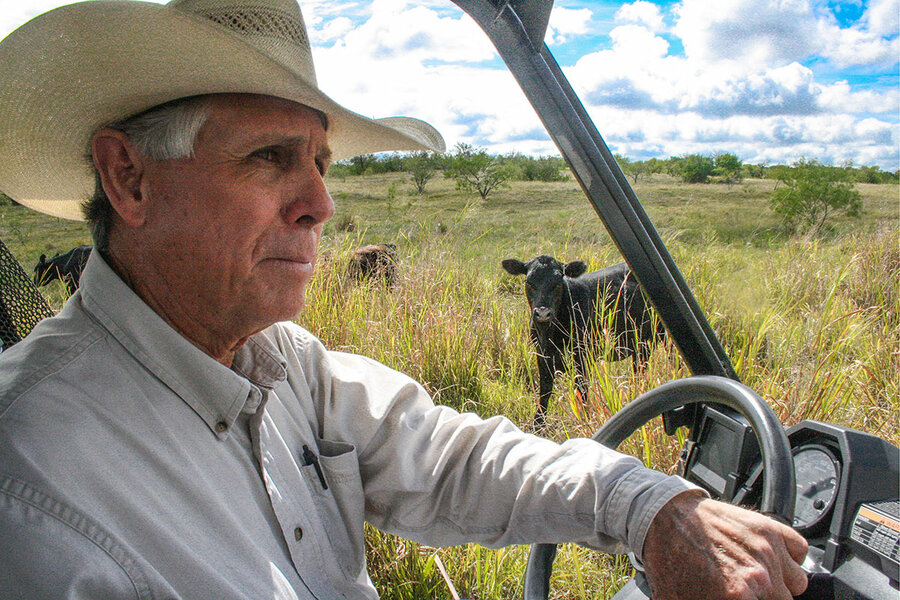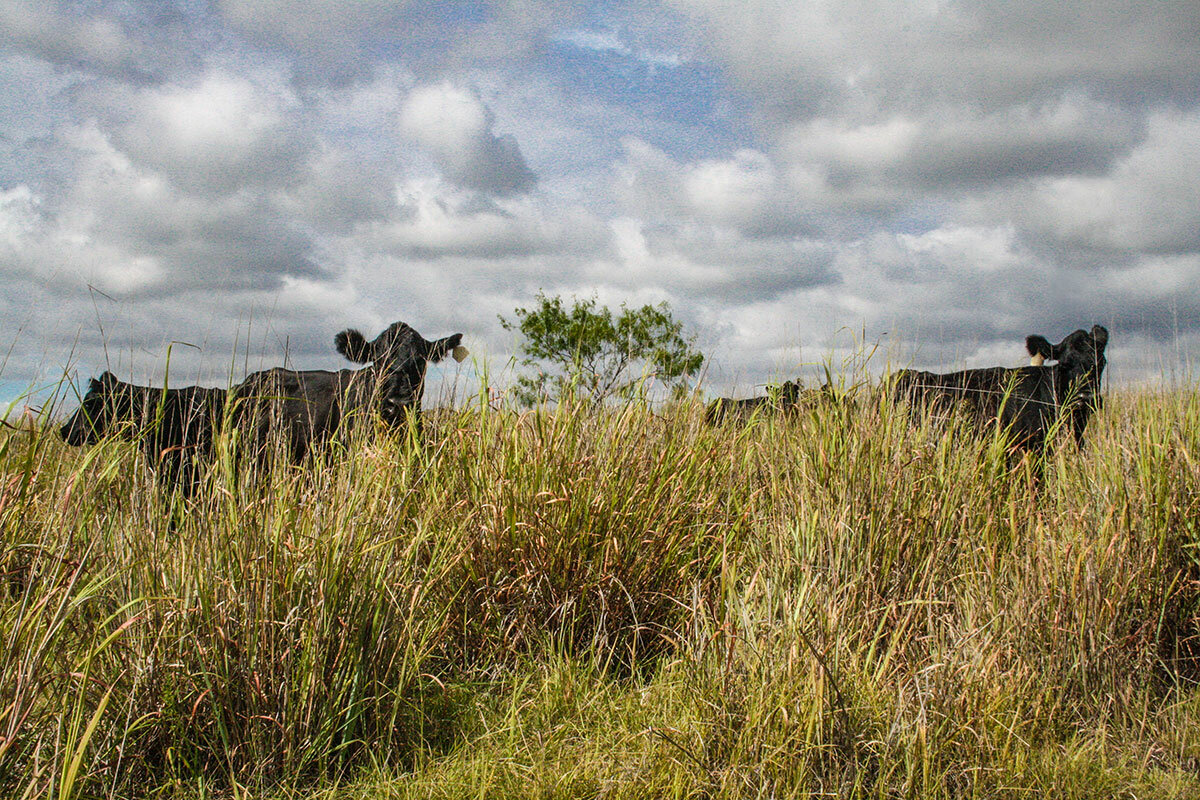Taller grasses, deeper roots: Texas ranchers adapt to era of extremes
Loading...
| Blooming Grove, Texas
Two months ago, the small Texas town of Emory saw its population almost double.
The surge lasted about a day, as a livestock auction attracted upward of 3,500 people looking to offload cattle – a sign of how extreme drought has been affecting ranchers’ ability to feed and water their herds. A line of trailers stretched for over 3 miles on July 9, and the auction stayed open until 5 a.m. the next day.
While areas like the Texas Panhandle are accustomed to severe drought, areas like Emory, less than 100 miles east of Dallas, are having to get used to it. Other pressures, like inflation and supply chain issues, are also adding up to a tough year for ranchers in the iconic Texas cattle industry.
Why We Wrote This
A story focused onDrought has imposed a harsh test on Texas cattle ranchers. But some have been adapting, even before this year, in ways that make them more resilient.
Beef producers are used to adapting to changing conditions, and those in Texas are innovating and building their long-term resilience to a changing climate. They are shifting how pastures are planted and managed, diversifying their cattle stock, and diversifying their businesses, too.
“If you look at 2011 to today, it’s amazing how far we’ve come in terms of producing beef more efficiently,” says Jaclyn Roberts, executive director of communications at the Texas and Southwestern Cattle Raisers Association, referring to the state’s last major drought.
“You can’t plan for a drought when it’s here. You plan years in advance, and I think that’s something more producers are doing,” she adds. “If we do see more intense and extreme swings in weather, I think we’re certainly prepared for that.”
Diversifying the rangeland
About a hundred miles southwest of Emory, Gary Price is preparing for the future – in part by looking to the past.
He has owned and operated the 77 Ranch with his wife, Sue, for 45 years, on about 2,600 acres of prairie he’s slowly acquired and converted from Great Depression-era cotton fields to a landscape from centuries earlier.
“We’re trying to duplicate what was going on a few hundred years ago with bison, roaming through and not staying long,” says Mr. Price.
That means planting their pastures with long, native grasses, as opposed to the short Bermuda grass many ranchers in this area use. And it means rotating the pastures their herds graze in every few weeks.
Walking through one of those pastures on a late August morning, his jeans are tucked into his cowboy boots to protect them from the damp grass. A few inches of late August rain have given the pastures a green flush, but signs of a recent two-month stretch of extreme heat and scarce rain are still visible. Sickly yellow grasses shake in the breeze, and rings of mud surround shallow rainwater ponds.
Month-long periods with no rain – Mr. Price calls them “mini droughts” – have grown more common, he says. “The intensity [of droughts] I think will be more pronounced” in the future.
The diverse ranch has had enough resources to see them through this drought so far. This morning a herd of cattle is chewing on grass. (Not long ago they’d been forced to graze on mesquite beans and lily pads.) The native grasses he’s planted over the decades are more drought-resistant than short grasses, and 47 of 75 stock tanks – those rain-fed ponds – have held enough water for the herd. Despite nine months of drought, they haven’t had to buy feed or haul water. He hasn’t bought fertilizer in decades.
They’ve had some fortune, Mr. Price admits. They sold some older cattle late last year, so when the drought hit they had relatively few to feed, for example. But they’ve made some of that fortune for themselves, he says.
The native grasses cover the soil, helping it retain moisture, which in turn helps the grass endure drought longer and recover quicker after rain. Rotating their herds over the years has also helped the grass grow longer and deeper. Keeping a diversity of grasses, ponds, and other food sources, like mesquite, means different pastures flourish in different conditions.
“This whole ranch has not had the same management for 45 years,” says Mr. Price. “You just have to be very, very flexible in this business.”
“You’ll never be able to control how much it rains, but we can control how much benefit we get from what moisture we get,” he adds.
“These are not quick fixes”
Although one of Mr. Price’s neighbors also has native grass pastures, other pastures near the 77 Ranch are visibly different. They’re mostly Bermuda grass, and on this late August morning the grass is brown and patchy, some soil washed into nearby ditches by the recent rains.
There’s nothing wrong with their approach, Mr. Price says – and it’s not his place to tell other producers how to manage their land – but “it’s not sustainable.”
“These are not quick fixes,” he admits. To grow pastures like those on the 77 Ranch, with their long, deep-rooted grasses, takes time, patience, and hard work. But “over time, growing a lot of grass, that’s the cheapest feed you’ve got. That’s what’s going to enable us to stay through hard times.”
Texas leads the country in beef production, generating over $10 billion in gross income last year, according to the U.S. Department of Agriculture (USDA). The 2011 drought cost the industry over $3 billion in livestock losses, and it’s been hit similarly hard this year – by drought and more – according to David Anderson, a livestock economist at Texas A&M AgriLife Extension Service.
The drought has been both long and intense, beginning last fall and peaking this summer with over 90% of the state experiencing drought conditions. Wildfires burnt up valuable pasture. There’s been inflation and high gas prices. The extreme heat has stressed cattle and hurt their ability to birth and wean calves, which will mean long-term difficulties. The geographic breadth of the drought has kept hay prices high due to widespread demand.
These conditions are especially tough on Texas ranchers, most of whom run smaller operations, says Dr. Anderson.
“We may not be talking about folks being forced to sell off their land,” he says, “but depending on how long [the drought] goes on, and the severity, they may have to sell all their cows.”
Then “it becomes expensive to start again,” he adds. “Some with land may choose to do that, but some may not.”
Producers in the state have been building their drought resiliency, experts say. They’ve been rotating herds through different pastures and building rain-fed stock tanks. They’ve also been breeding calves to improve longevity and resistance to drought and disease.
But again, those solutions aren’t financially viable for everyone, according to Ms. Roberts.
“The average producers [in Texas] are small,” she says. “It’s going to be harder for them to implement those changes at prices that make sense for them.”
What could especially help Texas producers in the long-term is diversifying their land use beyond cattle. Some ranchers in south Texas have combined ranching with hunting leases. That is something else Mr. Price has been developing over the years, including leasing his property to duck hunters and fishers. He’s also being paid for “ecosystem services” like storing carbon and cleaning stormwater.
Several of those ventures involve the connection between the 77 Ranch and the more than 7 million people who live in the Dallas-Fort Worth area an hour north. The Tarrant Regional Water District, which serves Fort Worth, is paying him through a USDA program to clean stormwater that flows to its water supply, for example.
The years of bison freely roaming the Texas landscape are long gone. But ranchers have adapted before, and they can continue to now, Mr. Price believes.
“Never has there been a time when there’s so much focus on the land by all people,” says Mr. Price. “I think it’s the most opportune time for landowners to make the connection with all of society. What we’re doing here impacts everybody.”
“We can have a sustainable ranch, a profitable ranch. We can benefit wildlife. We can hold soil in place. And we can provide recreation,” he adds. “It’s just a really good circle.”







